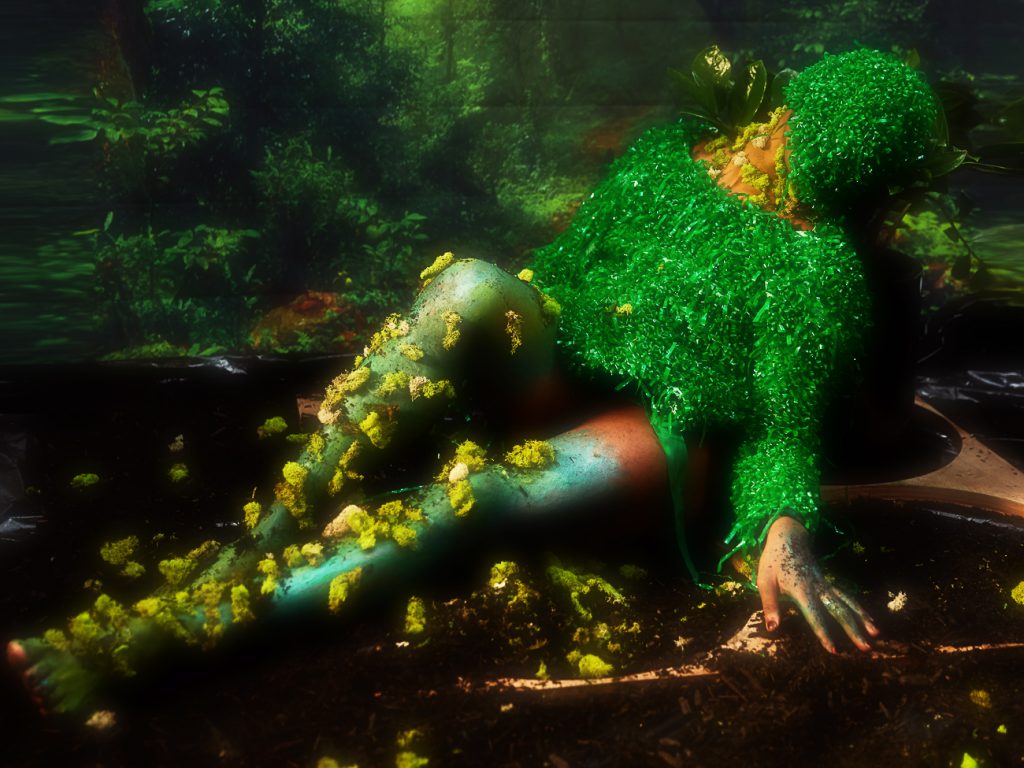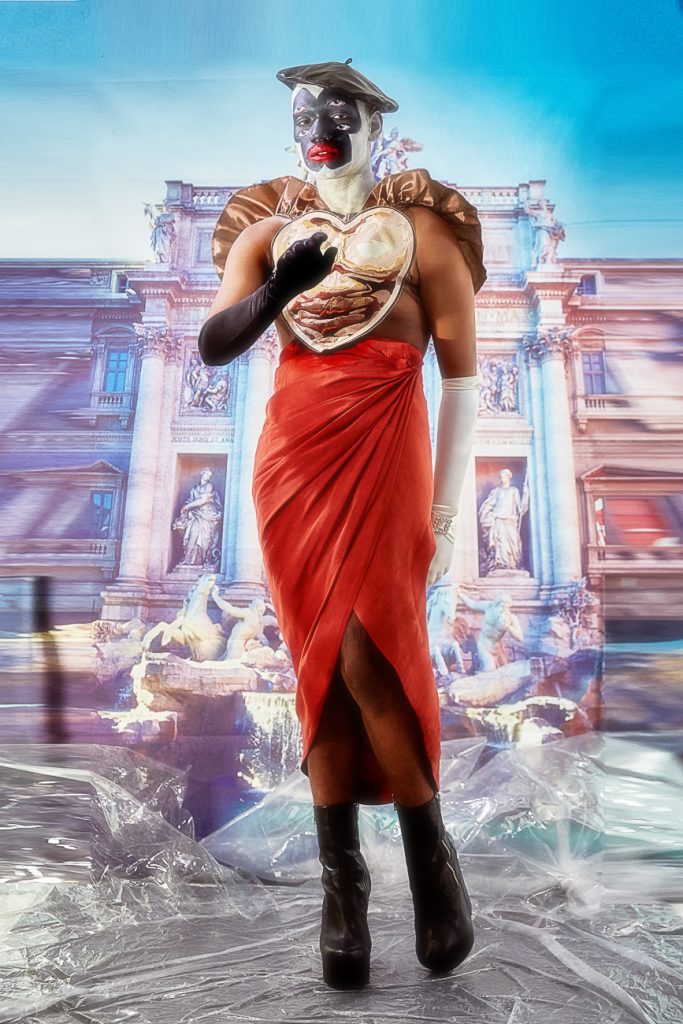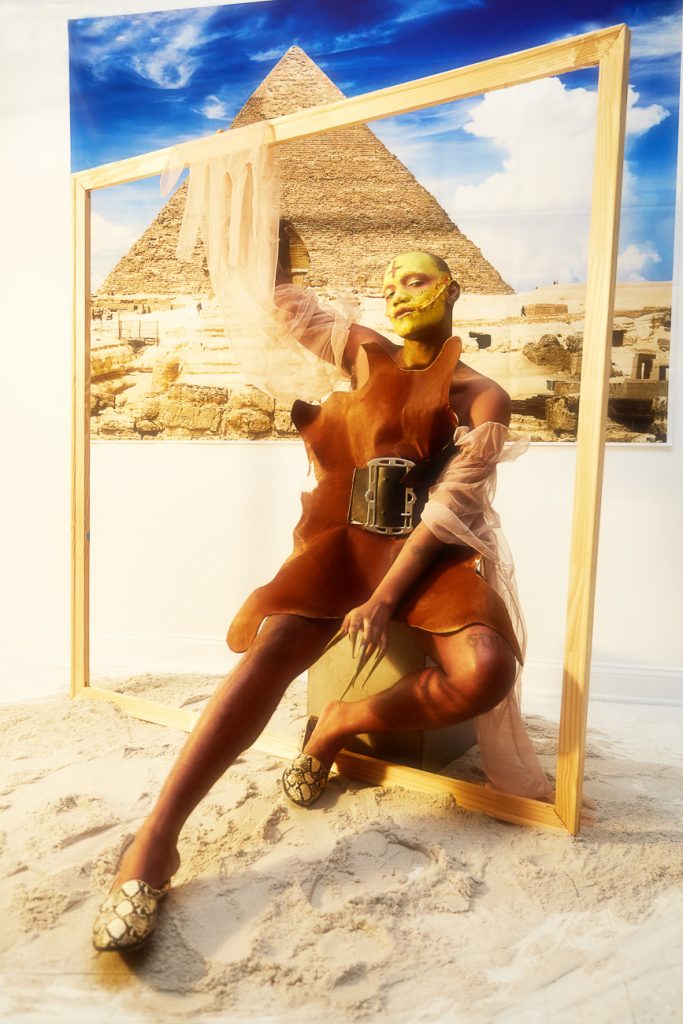This story by Holyrad Studio in Brooklyn came together in truth, as a response to the problematic commodification of queer imagery. Inspired by the genderqueer performance art of Hazkel Brown (aka Homosinner), this editorial challenges representation of the queer experience in the face of fashion’s artifice.
By expanding Hazkel’s unique explorations of queer identity into the broader sphere of a thoroughly detailed artificial environment, we illustrate the point that queer identity is more boundless than ever in a digital age that accommodates the growing positions of gender and identity, and that it is so important that we claim the fruits of our own culture.
Click the slideshow above to preview the editorial.

Handmade Astroturf Bodysuit and Mask by Maria Beniaris
“If you call yourself an advocate of the community you should advocate not only for yourself but everyone else who is part of that community.”
Hazkel speaks about this editorial collaboration with Holyrad Studio below:
“I feel like what got me into this project was necessarily the idea that gender is evolving.
I feel like to reclaim queerness is in a way also reclaiming my indigenous identity. What was fun and interesting throughout this photoshoot was being able to explore different identities, different groups, and different wonders of the world in a way that puts a person of color on a pedestal that hasn’t necessarily been put there before, where they’re no longer the servant or the one in suffering but they’re actually enjoying that environment — they’re having a lost moment.
Having control over my identity and how I present gives me ownership and an edge over people who might not have the ability to do so, or don’t need to do it due to their privilege.

Heart Shaped Harness: Vasilis / Draped Skirt: Devan Freedman / Silk Gloves: LaCrasia Gloves / Leather Beret: Eric Javitz / Boots: Syro
My great great grandfather was Antonio Saldaña who died in 1920. He was believed to be poisoned/assassinated by the U.S. food corp. He was the last indigenous king of Costa Rica. He was a huge advocate for preserving indigenous reserve and maintaining them intact. When the U.S. food corporation came into the Latin America, they wanted to begin to develop more in indigenous areas because those were the least developed areas where they could just set up plantations. I grew up in the tropics and lived in a rainforest so the idea of the Shaman was sort of how I envisioned the last dire moments of my great grandfather.
For the Egypt look in this editorial, I kept thinking about how photographers often go to Africa and take photos of some random people who they felt to be out of the norm compared to what they’re used to, and then they profit from those images, but they also create a whole different narrative of who those people actually are. I feel like that’s what I was thinking: over exaggerating what it is to be discovered, if I was to be discovered there. Would I be discovered and thought of as ‘new’ just by wearing ornaments and prosthetics? Would I be considered something else outside of the norm? Would I become grandiose or would I be considered a freak?

Deer Pelt Dress: Luar / Gloves: Friendship’s Clothing / Jewelry and Shoes: Stylist’s Own
It’s not about beauty at all. I try to play with things that have impacted me personally or things that I’ve noticed around the community like for example, racism and black face. I’ve encountered many people in my life who have done it. I’ve come across it very, very often. For me to recreate a look where I’m doing the foundation as white around my face but doing my face as black is reversing the blackface idea of who’s wearing it. Is it actually a white person with black face or is it a black person with black face?
It is easy to do something that can be considered racist, like black face. If you claim to be part of the community and you do something like that you should already know first hand that it’s wrong for you to do that. If you call yourself an advocate of the community you should advocate not only for yourself but everyone else who is part of that community.”
Check out the behind the scenes video below:
Editorial Credits:
Photographer and Set Design: Daryl Oh
Styling: Joe Van Overbeek
Subject and Makeup: Hazkel Brown Ch
Makeup: Indra
Videography: Lanee Bird
Video Editor: Saskia de Borchgrave
Holyrad Studio is an official Posture Membership Partner and offers one free studio day to all of our members! Become a Posture Member for only $45 annually to receive our annual print magazine, weekly updates from the team, invitations to special events, and discounts from our partners. Learn more here and join today! Thank you for supporting independent media.
